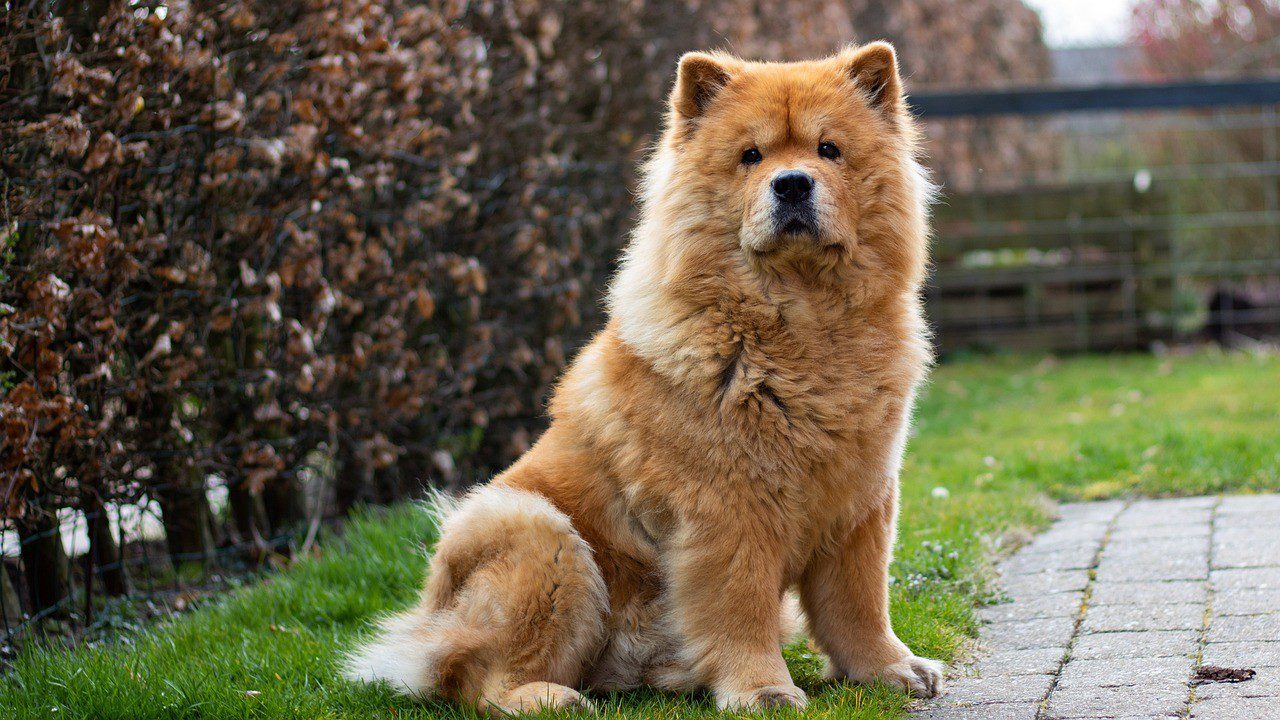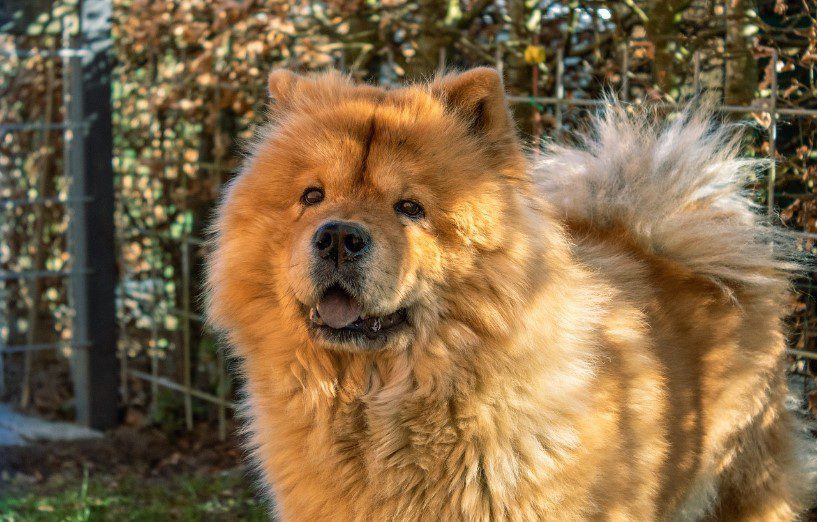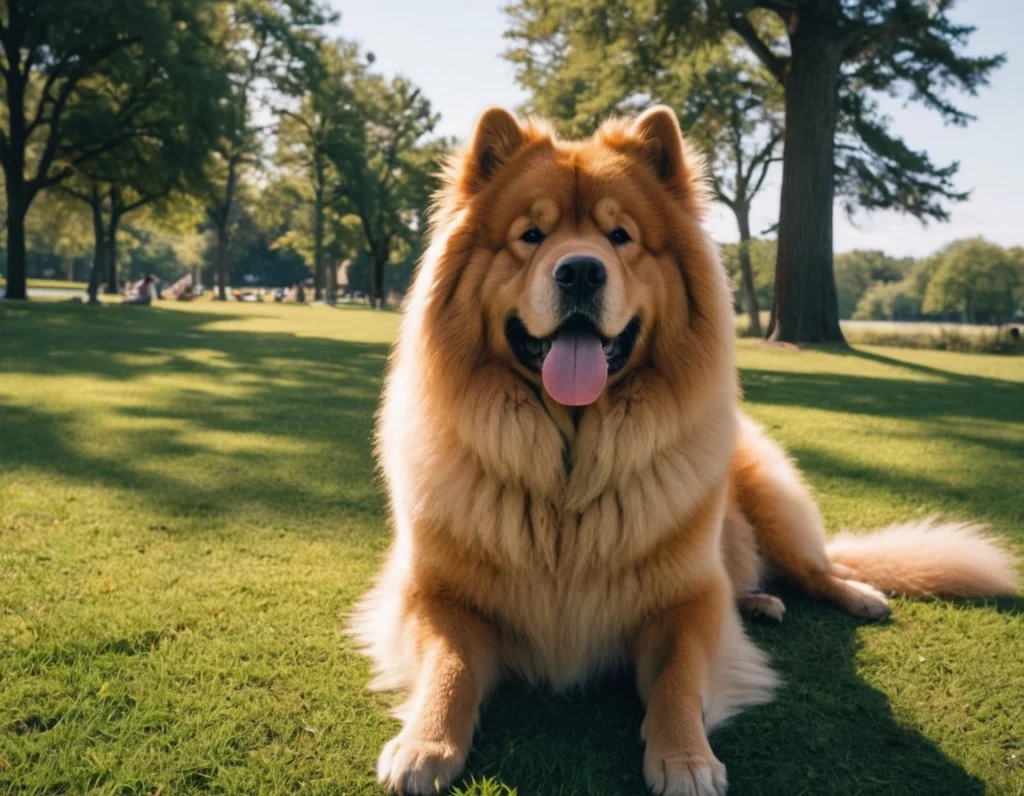With their lion-like mane, regal demeanor, and piercing almond-shaped eyes, the Chow Chow dog cuts a striking figure in the canine world. This ancient breed, originating from northern China, carries an air of mystery that has intrigued dog lovers for centuries. Yet behind their imposing appearance lies a complex personality often overshadowed by misconceptions. Are they aloof or affectionate? Independent or loyal? The answers might surprise you.
Distinctive Traits of the Chow Chow
- The Lion’s Mane: Their thick, fluffy coat—resembling a miniature lion—serves as both armor and insulation, a nod to their history as working dogs in harsh climates.
- A Tongue Like No Other: The Chow Chow’s unique blue-black tongue, shared only with the Shar-Pei, adds to their mystique. Folklore claims it holds healing powers, though science attributes it to a genetic quirk.
- A Mask of Aloofness: Their reserved nature is often mistaken for coldness. In reality, they form deep bonds with their families, expressing loyalty through quiet devotion rather than overt displays of affection.
Beyond the Stereotypes
Despite their dignified exterior, Chow Chows are playful and protective, often surprising owners with bursts of clownish energy. Their reputation as “difficult” stems largely from a mismatch between their needs and uninformed ownership. This article peels back the layers of myth, offering clarity on their temperament, care requirements, and the unique joys of sharing life with this enigmatic breed. Whether you’re considering adding a Chow Chow to your family or simply fascinated by their lore, prepare to see beyond the fluff—and discover why they’ve inspired admiration for over 2,000 years.

Myth 1: Aggression in Chow Chows
The notion that Chow Chows are inherently aggressive is one of the most pervasive—and misleading—stereotypes surrounding the breed. In reality, their behavior is often misunderstood, rooted in traits that once helped them thrive as guardians and hunters in ancient China. Let’s unravel the truth behind their temperament.
Guardians by Nature, Not Aggressors
Chow Chows are innately protective, a quality that can be mistaken for hostility. Their wariness toward strangers isn’t aggression but a centuries-old instinct to safeguard their family and territory. Unlike breeds bred for confrontation, Chows prioritize observation over action. As the American Kennel Club (AKC) notes, their aloofness is “dignified, not hostile,” reflecting their role as discerning companions rather than indiscriminate threats.
Loyalty vs. Misinterpretation
- Family Bonding: Chow Chows form intense, loyal bonds with their households. Their “aloof” label fades at home, where they’re often described as quietly affectionate—think of a stoic sentry who’ll curl up at your feet, not a distant loner.
- Stranger Caution: Their reserved demeanor with outsiders is a protective mechanism, not a sign of volatility. Early socialization helps them distinguish between genuine threats and friendly visitors.
Expert Insights
Veterinary behaviorists emphasize that Chow Chows are no more prone to aggression than other guardian breeds. Dr. Emily Wilson, a certified canine behavior consultant, explains: “Their reputation suffers from a lack of understanding. A well-socialized Chow is calm, discerning, and deeply loyal—traits often misread as ‘aggressive’ by those unfamiliar with the breed.”
Actionable Tips for a Well-Balanced Chow
- Early Socialization: Expose puppies to diverse environments, people, and animals to build confidence. Focus on positive experiences to counteract innate caution.
- Positive Reinforcement: Reward calm, non-reactive behavior. Harsh training can heighten wariness, while patience fosters trust.
- Supervised Interactions: Manage encounters with strangers or unfamiliar dogs to prevent misunderstandings.
Rethinking the Narrative
Labeling Chow Chows as “aggressive” oversimplifies their complex temperament. With proper guidance, they blossom into steadfast, intuitive companions. For those willing to respect their boundaries and invest in training, the payoff is a loyal partner whose bark is far, far worse than their bite.

Myth 2: Exercise Needs of Chow Chows
At first glance, the Chow Chow’s plush coat and dignified posture might suggest a lapdog’s laziness. Yet labeling them as “low-energy” oversimplifies their needs—and risks underserving their physical and mental health. Let’s debunk the myth and explore how to keep these majestic dogs balanced.
The Truth About Their Energy
Chow Chows thrive on moderation. Bred for tasks like herding and guarding, they possess a quiet vigor that doesn’t demand marathon runs but requires consistent engagement. “They’re like a slow-burning ember,” says veteran Chow Chow breeder Lena Torres. “Their energy isn’t flashy, but it’s steady. Ignore it, and you’ll see restlessness—or boredom-induced stubbornness.”
Heat Sensitivity: A Critical Consideration
Their dense double coat, while glorious, makes them prone to overheating. Exercise routines must adapt to this:
- Timing Matters: Schedule walks during cooler mornings or evenings in warmer climates.
- Hydration Always: Carry water and avoid prolonged sun exposure.
- Indoor Alternatives: Swap a midday hike for a game of fetch in an air-conditioned room.
Tailored Activities for Independent Spirits
Chow Chows aren’t ones to fetch balls endlessly or sprint laps. Instead, align activities with their instincts:
- Purposeful Strolls: A 20-30 minute walk daily satisfies their need to patrol their domain. Let them sniff and explore at their own pace.
- Mental Gymnastics: Puzzle toys, scent games, or hide-and-seek tap into their problem-solving roots.
- Obedience Challenges: Short training sessions (5-10 minutes) with rewards for compliance cater to their love of mastery.
The Danger of under stimulation
Without adequate outlets, Chow Chows may channel energy into destructive habits—digging, chewing, or stubbornness. “Their independence is a double-edged sword,” notes dog trainer Marco Reyes. “They’ll entertain themselves if you don’t, and their choices might surprise you.”
Balancing Act: Tips for Success
- Respect Their Limits: Pushing for high-intensity exercise can strain joints or overheat them.
- Embrace Quiet Companionship: A calm afternoon lounging near their owner is just as vital as play.
- Rotate Enrichment: Mix physical activity with mental challenges to prevent monotony.
Rethinking “Lazy”
Calling Chow Chows “low-energy” isn’t entirely wrong—it’s just incomplete. They’re deliberate, not dormant, thriving when their exercise and mental needs align with their regal pace. By honoring their unique rhythm, owners unlock a companion who’s both serene and surprisingly spirited.
Myth 3: Health Issues in Chow Chows
The Chow Chow’s majestic appearance often comes with whispers about health problems, painting them as fragile or short-lived. While they do have breed-specific risks, labeling them “unhealthy” ignores the power of proactive care. With attention to their unique needs, these dogs can thrive well into their teens—a testament to their hardy heritage as working companions.
Common Concerns, Manageable Solutions
Like many large breeds, Chow Chows face genetic predispositions, but knowledge and routine care can mitigate risks:
- Hip Dysplasia: Their sturdy build can strain joints. Regular vet screenings, weight management, and supplements like glucosamine help preserve mobility.
- Eye Conditions: Entropion (inward-turning eyelids) and corneal dystrophy are treatable with early detection. Weekly eye checks and veterinary ophthalmologist visits are key.
- Skin & Coat Care: Their thick double coat requires daily brushing to prevent matting, which can trap moisture and cause infections. Hypoallergenic wipes between baths reduce allergens and irritation.
Prevention as a Lifestyle
“Chow Chows aren’t high-maintenance—they’re highly responsive to preventive care,” says Dr. Raj Patel, a veterinarian specializing in breed-specific health. Key strategies include:
- Diet Tailored to Their Needs: High-quality protein supports muscle health, while omega-3s from fish oil combat skin dryness.
- Climate Control: Avoid extreme heat to protect their dense coat and joints; invest in cooling mats for summer comfort.
- Routine Screenings: Annual bloodwork and orthopedic exams catch issues before symptoms arise.
The Role of Genetics
Reputable breeders screen for conditions like hip dysplasia and eye disorders, emphasizing the importance of sourcing puppies from health-conscious lineages. Prospective owners should ask for clearances from organizations like the Orthopedic Foundation for Animals (OFA).
A Legacy of Resilience
Historically, Chow Chows survived harsh northern climates and demanding labor—proof of their innate resilience. Modern care simply builds on that foundation. By addressing their needs thoughtfully, owners honor the breed’s history while ensuring a vibrant future.
Myth 4: Training Challenges with Chow Chows
The Chow Chow’s reputation for being “stubborn” has followed them like their signature mane—but this myth crumbles under scrutiny. Their independent streak, often compared to a cat’s, isn’t defiance. It’s a reflection of their history as self-reliant working dogs. Training them isn’t about dominance; it’s about speaking their language.
Decoding the “Stubborn” Label
Chow Chows learn quickly—they just prioritize their agenda. “They’re thinkers, not robots,” explains professional trainer Sarah Lin. “If they don’t see the point of a command, they’ll ignore it. But once they trust you, they’ll follow cues with surprising enthusiasm.” Their loyalty becomes your secret weapon: frame training as a collaborative game, not a chore.
Training Tips: Patience Meets Positivity
- Start Early, Stay Consistent:
Begin with puppyhood socialization and basic commands like “sit” or “stay.” Use short (5-10 minute) sessions to match their attention span. - Leverage High-Value Rewards:
Tempt their foodie side with chicken, cheese, or freeze-dried liver. Reward calm focus, not just compliance. - Respect Their Pace:
If they resist a task, pause and revisit it later. Pushing triggers stubbornness; flexibility fosters trust. - Crate Training as a Safe Space:
Introduce crates early as a cozy den, not punishment. Their instinct to guard territory makes them quick to adopt it as their own.
The Power of Routine
Chow Chows thrive on predictability. Reinforce commands daily in low-distraction environments before advancing to real-world scenarios. For leash training:
- Let them sniff and explore on a loose lead.
- Use treats to reward walking by your side.
- Gradually phase out treats, replacing them with praise.
Avoiding Common Pitfalls
- Harsh Corrections Backfire: Yelling or physical discipline erodes trust, triggering wariness or shutdowns.
- Overlooking Mental Stimulation: A bored Chow Chow invents mischief. Rotate puzzle toys or teach tricks like “high five” to channel their intellect.
A Bond Built on Mutual Respect
Training a Chow Chow isn’t about bending them to your will—it’s about earning their respect. “They’re partners, not subordinates,” says breeder James Wong. “When they choose to obey, it’s because they want to please you.” This dynamic transforms perceived stubbornness into quiet dedication.
Rewriting the Narrative
Yes, Chow Chows require patience. But their loyalty and sharp minds make breakthroughs deeply rewarding. With empathy and consistency, even the most headstrong Chow becomes a responsive, cherished companion—proving that “stubborn” is just another word for “discerning.”
Myth 5: Chow Chows and Other Pets
The image of the Chow Chow as a solitary guardian, wary of intruders, fuels the myth that they can’t coexist with other animals. Yet countless households thrive with Chow Chows alongside cats, dogs, and even smaller pets—proof that harmony is possible with the right approach.
Understanding Their Instincts
Chow Chows are territorial by design, a trait honed from centuries of guarding homes and livestock. “They’re not inherently hostile to other animals,” says multi-pet owner and Chow Chow advocate Maria Chen. “But they need to feel their space—and their role as protector—is respected.” Their wariness often stems from uncertainty, not malice.
Strategies for Successful Integration
- Early Socialization is Key:
Introduce puppies to other pets gradually, using neutral territory (like a park) to avoid territorial reactions. Reward calm interactions with treats. - Respect Their Boundaries:
Allow the Chow Chow to initiate contact. Forcing interactions breeds resentment; patience lets trust develop naturally. - Create Safe Zones:
Designate separate feeding areas and sleeping spaces. A raised dog bed or cat tree gives smaller pets vertical escape routes.
Real-Life Success Stories
Take Luna, a 3-year-old Chow Chow who shares her home with a tabby cat and a Pomeranian. “Luna ignored them at first,” recalls owner David Park. “But after months of supervised coexistence, she now grooms the cat and plays ‘chase’ with the Pom. It’s all on her terms, though—if the cat swats her, Luna just walks away.”
Tips for Multi-Pet Harmony
- Supervise Initial Meetings:
Use baby gates or leashes to manage first interactions. Look for relaxed body language (soft eyes, wagging tail) as a green light. - Manage Resources:
Food bowls, toys, and even your attention can trigger possessiveness. Feed pets separately and avoid giving high-value treats in shared spaces. - Leverage Their Loyalty:
Involve the Chow Chow in caregiving routines, like handing out treats or leading walks. This reinforces their role as a leader without aggression.
When Challenges Arise
Some Chow Chows may never warm up to other animals—and that’s okay. “It’s about setting realistic expectations,” advises trainer Lisa Nguyen. “Not all dogs need to be best friends. Peaceful coexistence, with mutual respect, is a win.”
Rewriting the Script
The Chow Chow’s reputation as a loner overlooks their adaptability. With empathy and structure, they can become gracious housemates, their protective instincts channeled into watching over—not dominating—their furry family. As Maria Chen puts it: “They’re not antisocial. They’re selectively social. And that’s a trait worth nurturing.”
Conclusion: Is a Chow Chow Right for You?
The Chow Chow defies stereotypes—this ancient breed is neither a menace nor a mystery, but a complex blend of dignity, loyalty, and charm. Their lion-like mane and sapphire-black tongue hint at their storied past, yet their future hinges on owners who understand their nuances.
Key Takeaways
- Not a Breed for Everyone: Their independent spirit demands respect, not resistance.
- Rewards of Patience: In return for training, grooming, and boundaries, they offer unwavering devotion.
- Health Over Hype: Proactive care transforms potential challenges into manageable routines.
Ask Yourself
Before welcoming a Chow Chow into your life, consider:
- Can you commit to their grooming ritual? Their coat isn’t just majestic—it’s a lifelong responsibility.
- Do you value calm companionship over clingy affection? Their love is quiet but profound.
- Are you prepared to advocate for them? Their aloofness may be misjudged by others.
A Call to Future Owners
If you’re drawn to their mystique but unsure about the commitment, connect with Chow Chow communities or volunteer to foster. “Living with a Chow Chow changes you,” shares longtime owner Anita Rao. “They’re not a pet—they’re a legacy.”
Join the Conversation
Are you ready to embrace the Chow Chow’s unique blend of fire and serenity? Share your thoughts—or your own Chow story—in the comments. Your insights could help another reader decide if this extraordinary breed is their perfect match.



